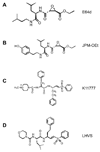Cysteinyl cathepsins and mast cell proteases in the pathogenesis and therapeutics of cardiovascular diseases
- PMID: 21605595
- PMCID: PMC3134138
- DOI: 10.1016/j.pharmthera.2011.04.010
Cysteinyl cathepsins and mast cell proteases in the pathogenesis and therapeutics of cardiovascular diseases
Abstract
The initiation and progression of cardiovascular diseases involve extensive arterial wall matrix protein degradation. Proteases are essential to these pathological events. Recent discoveries suggest that proteases do more than catabolize matrix proteins. During the pathogenesis of atherosclerosis, abdominal aortic aneuryms, and associated complications, cysteinyl cathepsins and mast cell tryptases and chymases participate importantly in vascular cell apoptosis, foam cell formation, matrix protein gene expression, and pro-enzyme, latent cytokine, chemokine, and growth factor activation. Experimental animal disease models have been invaluable in examining each of these protease functions. Deficiency and pharmacological inhibition of cathepsins or mast cell proteases have allowed their in vivo evaluation in the setting of pathological conditions. Recent discoveries of highly selective and potent inhibitors of cathepsins, chymase, and tryptase, and their applications in vascular diseases in animal models and non-vascular diseases in human trials, have led to the hypothesis that selective inhibition of cathepsins, chymases, and tryptase will benefit patients suffering from cardiovascular diseases. This review highlights recent discoveries from in vitro cell-based studies to experimental animal cardiovascular disease models, from protease knockout mice to treatments with recently developed selective and potent protease inhibitors, and from patients with cathepsin-associated non-vascular diseases to those affected by cardiovascular complications.
Copyright © 2011 Elsevier Inc. All rights reserved.
Figures



Similar articles
-
Mast cell chymase and tryptase as targets for cardiovascular and metabolic diseases.Curr Pharm Des. 2013;19(6):1114-25. doi: 10.2174/1381612811319060012. Curr Pharm Des. 2013. PMID: 23016684 Free PMC article. Review.
-
Cysteine protease cathepsins in cardiovascular disease: from basic research to clinical trials.Nat Rev Cardiol. 2018 Jun;15(6):351-370. doi: 10.1038/s41569-018-0002-3. Nat Rev Cardiol. 2018. PMID: 29679024 Review.
-
Mast cell proteases as pharmacological targets.Eur J Pharmacol. 2016 May 5;778:44-55. doi: 10.1016/j.ejphar.2015.04.045. Epub 2015 May 7. Eur J Pharmacol. 2016. PMID: 25958181 Free PMC article. Review.
-
Mast cell chymase and tryptase in abdominal aortic aneurysm formation.Trends Cardiovasc Med. 2012 Aug;22(6):150-5. doi: 10.1016/j.tcm.2012.07.012. Epub 2012 Aug 14. Trends Cardiovasc Med. 2012. PMID: 22902093 Free PMC article. Review.
-
Mast cell cathepsins C and S control levels of carboxypeptidase A and the chymase, mouse mast cell protease 5.Biol Chem. 2003 Oct-Nov;384(10-11):1527-31. doi: 10.1515/BC.2003.169. Biol Chem. 2003. PMID: 14669996
Cited by
-
Transfer of exosomal microRNA-203-3p from dendritic cells to bone marrow-derived macrophages reduces development of atherosclerosis by downregulating Ctss in mice.Aging (Albany NY). 2021 Jun 2;13(11):15638-15658. doi: 10.18632/aging.103842. Epub 2021 Jun 2. Aging (Albany NY). 2021. PMID: 34077394 Free PMC article.
-
Role of Extracellular Matrix and Inflammation in Abdominal Aortic Aneurysm.Int J Mol Sci. 2022 Sep 21;23(19):11078. doi: 10.3390/ijms231911078. Int J Mol Sci. 2022. PMID: 36232377 Free PMC article. Review.
-
Single nucleotide polymorphisms of cathepsin S and the risks of asthma attack induced by acaroid mites.Int J Clin Exp Med. 2015 Jan 15;8(1):1178-87. eCollection 2015. Int J Clin Exp Med. 2015. PMID: 25785111 Free PMC article.
-
Effect of poloxamer 407 administration on the serum lipids profile, anxiety level and protease activity in the heart and liver of mice.Interdiscip Toxicol. 2013 Mar;6(1):18-25. doi: 10.2478/intox-2013-0004. Interdiscip Toxicol. 2013. PMID: 24170975 Free PMC article.
-
Dilating Vascular Diseases: Pathophysiology and Clinical Aspects.Int J Vasc Med. 2018 Aug 26;2018:9024278. doi: 10.1155/2018/9024278. eCollection 2018. Int J Vasc Med. 2018. PMID: 30225143 Free PMC article. Review.
References
Publication types
MeSH terms
Substances
Grants and funding
LinkOut - more resources
Full Text Sources

